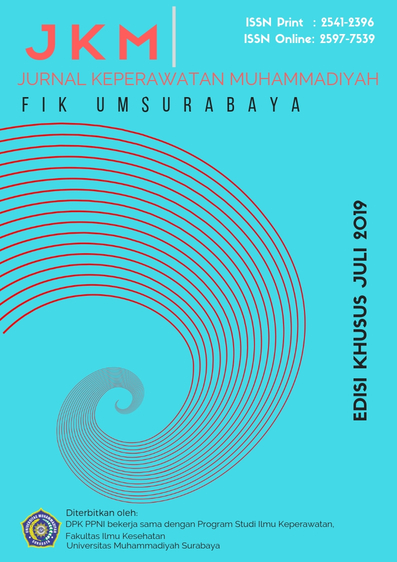Gambaran Quality of Work life Perawat di Rumah Sakit Tipe B
DOI:
https://doi.org/10.30651/jkm.v4i2.2027Abstract
Background. Quality Of Work Life (QWL) is a process in which employees and stakeholders work to improve the quality of life of employees and organizational performance simultaneously. Nurses are one of the service personnel who have greater and longer interactions with patients. QWL is a degree of fulfillment of human needs in the work environment. If human needs have reached, it can increase productivity. This gives an understanding that QWL is the main problem that gives attention to the organization because it allows to increase the participation of members in the organization.
Aim. To determine the QWL level of nurses and predictable factors affecting QWL nurses in hospitals.
Method. The study uses a cross-sectional approach. The population came from type B hospitals in Makassar, Indonesia with a sample that was meaningful for more than 1 year and respondents obtained 287 nurses. Data were collected by questionnaire and test which was a linear regression with a significance value of 0.001.
Results. The results of QWL nurses are at the moderate level and also in each of the QWL dimensions. The best predictors of QWL nurses working in type B hospitals were marital status (b = -0.199) which was able to have an impact on QNWL of 55%.
Conclusion. Dimensions and overall QWL nurses are at a moderate level. QWL is important to identify capacity in meeting the needs of both the community and the workplace.References
Akter, N., Akkadechanunt, T., Chontawan, R., & Klunklin, A. (2017). Factors predicting quality of work life among nurses in tertiary-level hospitals, Bangladesh. International Nursing Review, 64(4), 1–8. http://doi.org/10.1111/inr.12401
Amin, Z. (2013). Quality of Work Life in Indonesian Public Service Organizations: The Role of Career Development and Personal Factors. International Journal of Applied Psychology, 3(3), 38–44. http://doi.org/10.5923/j.ijap.20130303.02
Beaudoin, L. E., & Edgar, L. (2003). Hassles: Their Importance to Nurses’ Quality of Work Life. Nursing Economic$, 21(3).
Brooks, B. A., & Anderson, M. A. (2005). Defining Quality of Nursing Work Life. Nursing Economic$, 23(6).
Clarke, P. N., & Brooks, B. (2010). Quality of nursing worklife: Conceptual clarity for the future. Nursing Science Quarterly, 23(4), 301–305. http://doi.org/10.1177/0894318410380268
Devi, B. R., & Hajamohideen, O. M. (2018). A Study on Quality of Work Life among Nurses Working In Private Hospitals an Thanjavur, Tamilnadu. IOSR Journal of Business and Management Ver. I, 20(4), 61–63. http://doi.org/10.9790/487X-2004026163
Horst, D. J., Broday, E. E., Bondarick, R., Filippe Serpe, L., & Pilatti, A. (2014). Quality of Working Life and Productivity : An Overview of the Conceptual Framework. International Journal of Managerial Studies and Research, 2(87), 2349–330.
Huber, D. L. (2010). Leadership and Nursing Care Management (4th ed.). Suanders Elsevier.
Kelbiso, L., Belay, A., & Woldie, M. (2017). Determinants of Quality of Work Life among Nurses Working in Hawassa Town Public Health Facilities , South Ethiopia : A Cross-Sectional Study. Nursing Research and Practice, 2017.
Kementrian Kesehatan Republik Indonesia. (2017). Situasi Tenaga Keperawatan Indonesia 2017. http://doi.org/http://www.depkes.go.id/resources/download/pusdatin/infodatin/infodatin%20perawat%202017.pdf
Muindi, F., & K ’obonyo, P. (2015). Quality of Work Life, Personality, Job Satisfaction, Competence, and Job Performance: a Critical Review of Literature. European Scientific Journal, 1111(2626), 1857–7881.
Saleh, A., Ramly, M., Gani, M. U., & Suriyanti. (2016). Factors Affecting The Job Satisfaction And Performance Of Nurses Private Hospitals Class B In Makassar. International Journal Of Scientific & Technology Research, 5(10).
Samanthi, F. (2015). Identifikasi Kualitas Kehidupan Kerja Perawat Di Instalasi Rawat Inap Rumah Sakit PKU Muhammadiyah Yogyakarta Unit II. Universitas Muhammadiyah Yogyakarta.
Sheel, S., Sindhwani, B. K., Goel, S., & Pathak, S. (2012). Quality of Work Life , Employee Performance and Career Growth Opportunities : a Literature Review. International Journal of Multidisciplinary Research, 2(2), 291–300.
Sirgy, M. J., Efraty, D., Siegel, P., & Lee, D. J. (2001). A new measure of quality of work life (QWL) based on need satisfaction and spillover theories. Social Indicators Research, 55(3), 241–302. http://doi.org/10.1023/A:1010986923468
Sjahruddin, H., & Sudiro, A. A. (2013). Organizational justice, organizational commitment and trust in manager as predictor of organizational citizenship behavior. Interdisciplinary Journal of Contemporary Research in Business, 4(12), 133–142.
Vagharseyyedin, S. A., Vanaki, Z., & Mohammadi, E. (2011). The Nature Nursing Quality of Work Life : An Integrative Review of Literature. Western Journal of Nursing Research, 33(6), 786–804. http://doi.org/10.1177/0193945910378855
Downloads
Published
Issue
Section
License
- Penulis tetap memegang hak atas karyanya dan memberikan hak publikasi pertama kepada jurnal ini yang secara simultan karya tersebut dilisensikan di bawah:Â Creative Commons Attribution-ShareAlike 4.0 International (CC BY-SA 4.0)













